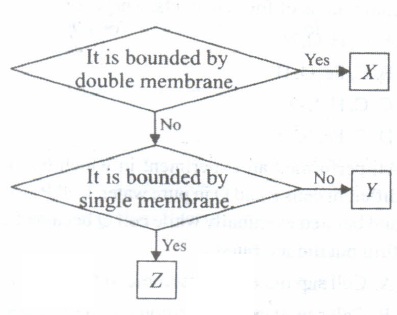

SAT Biology - Cells and Tissues
Exam Duration: 45 Mins Total Questions : 30
The two major process of wound healing are
- (a)
Regeneration and fibrosis
- (b)
Fibrosis and tissue formation
- (c)
Ingrowth and granulation
- (d)
Regeneration and replacement
Which of the following is not a function of epithelial tissue?
- (a)
Covers surfaces
- (b)
Secretion and absorption
- (c)
Support of the body
- (d)
Lining of the digestive track
Mast cell occur in ___________
- (a)
Nervous tissue
- (b)
Connective tissue
- (c)
Epithelial tissue
- (d)
Skeletal tissue
Xylem vessels have walls impregnated with
- (a)
Cutin
- (b)
Chitin
- (c)
Keratin
- (d)
Lignin
Cork is waterproof because its cell walls are impregnated with
- (a)
Chitin
- (b)
Suberin
- (c)
Keratin
- (d)
Pillin
The primary function of muscle tissue is to
- (a)
Contract
- (b)
Shorten
- (c)
Both A & B
- (d)
Protect the body from harmful U.V rays
Which of the following has slowest growth rate?
- (a)
Connective tissue
- (b)
Epithelial tissue
- (c)
Nervous tissue
- (d)
None of these
Which tissue makes plants hard & stiff?
- (a)
Sclerenchymatous tissue
- (b)
Epidermal tissue
- (c)
Squamous epithelial tissue
- (d)
None of the above
Parenchyma: Simple :: Phloem _________
- (a)
Simple
- (b)
Collenchyma
- (c)
Complex
- (d)
Xylem
__________ tissue forms new cells in plants.
- (a)
Meristematic
- (b)
Permanent
- (c)
Simple
- (d)
None of the above
________ tissues prevent loss of water in plants.
- (a)
Protective
- (b)
Xylem
- (c)
Phloem
- (d)
All of the above
Active division takes place in the cells of _________
- (a)
Xylem
- (b)
Phloem
- (c)
Sclerenchyma
- (d)
Cambium
The largest animal cell is ________
- (a)
Ostrich egg
- (b)
Amoeba
- (c)
Red blood corpuscle
- (d)
Human sperm
Cell theory was propounded by
- (a)
Morgan
- (b)
Halden
- (c)
Schleiden and Schwann
- (d)
Robert Hooke
ER was discovered by
- (a)
Robert Brown
- (b)
Porter
- (c)
A.V. Leeuwenhoek
- (d)
Schwann
Which of the following is called as 'Suicidal bags'?
- (a)
Centrosome
- (b)
Lysosome
- (c)
Microsome
- (d)
Mesosomes
Double membrane is absent in
- (a)
mitochondrion
- (b)
chloroplast
- (c)
nucleus
- (d)
lysosome
Which organelle releases oxygen?
- (a)
Ribosome
- (b)
Golgi apparatus
- (c)
Mitochondria
- (d)
Chloroplast
The membrane surrounding the vacuole of a plant cell is called
- (a)
tonoplast
- (b)
plasma membrane
- (c)
nuclear membrane
- (d)
cell wall
Nucleoplasm is continuous with cytoplasm through
- (a)
centriole
- (b)
golgi apparatus
- (c)
nuclear pores
- (d)
endoplasmic reticulum
The function of the nucleolus in the cell is
- (a)
secretory
- (b)
synthesis of DNA
- (c)
synthesis of RNA and ribosomes
- (d)
none of these
Which of the following would not be considered part of a cell's cytoplasm?
- (a)
Ribosome
- (b)
Nucleus
- (c)
Mitochondrion
- (d)
Microtubule
Which one is not a part of nucleus?
- (a)
Chromatin
- (b)
Nucleolus
- (c)
Centrosome
- (d)
Nucleoplasm
Glycocalyx is:-
- (a)
glycoproteins and glycolipids
- (b)
oligosaccharide part of glycolipids and glycoproteins
- (c)
lipid and protein parts of glycolipids
- (d)
mucopolysaccharides attached to cell wall
Study the given flow chart regarding some cell organelles present in a cell.

Which of the following options is incorrect regarding X, Y and Z?
- (a)
Organelle X can transform solar energy into chemical energy of carbohydrates.
- (b)
Enzymes of organelle F are present in the acrosome of human sperm cell which digest the limiting membrane of ovum during fertilization.
- (c)
On starvation, organelle Z digests stored food contents and other cellular components; this process is called as autophagy.
- (d)
Organelle X can bring about stepwise oxidation of carbohydrates to produce CO2 and water
Plastids are cytoplasmic organelles found in plant cells and in certain protists. All plastids have essentially the same structure because
(i) they have to perform the same function
(ii) they are localised in the aerial parts of plant
(iii) one type of plastid can differentiate into another type of plastid depending upon the cell requirements
(iv) all plastids have to store starch, lipids and proteins.
Which of the above mentioned statement(s) is/are correct,
- (a)
(i) and (ii)
- (b)
(ii) and (iii)
- (c)
(iii) only
- (d)
(i) and (iv)
Cell wall is
- (a)
Selectively permeable
- (b)
Impermeable
- (c)
Fully permeable
- (d)
Sometime impermeable and sometime semipermeable
Cristae are a series of infoldings of inner membrane in:
- (a)
Chloroplast
- (b)
Golgi complex
- (c)
Mitochondria
- (d)
Endoplasmic reticulum
Membrane of the plant cell vacuole is known as
- (a)
Tonoplast
- (b)
Protoplast
- (c)
Cell membrane
- (d)
Vacuole membrane
Which of the following organelle is a storage organelle?
- (a)
Leucoplast
- (b)
Chromoplast
- (c)
Ribosome
- (d)
Mitochondria







